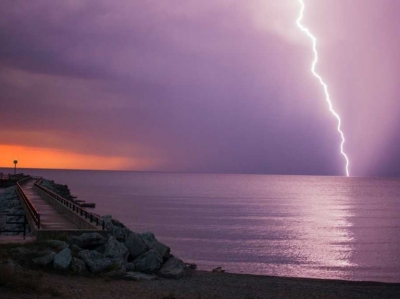
Lightning is “a sudden electrostatic discharge that occurs during a thunderstorm.” It can happen within a cloud, between two clouds, or between a cloud and the ground. This is why lightning seems to travel in every possible direction. There’s a lot of power behind that giant static shock. Let’s illustrate.
Lightning bolts vary in power. On average their current is between 10 million and 100 million volts, with an average amperage of 30,000 amps. The rapid transfer of so much energy has a dramatic effect on the matter around it. The air around a bolt heats to temperatures as high as 54,000 Fahrenheit. That’s hotter than the surface of the sun.
It can be hard to wrap your head around those numbers. They’re so far from our everyday human experience with electricity. So let’s keep it simple and just say that it’s enough power to vaporize solid sand. That’s right, in the millionth of a second it takes for lightning to strike, it turns solid matter into a gas.
When lightning strikes a body of water, what happens is simple. The electric charge doesn’t penetrate far into the water. This is why there aren’t dozens of dead fish popping up after every storm. Instead, it spreads along the surface, discharging horizontally. As for how far it can spread, estimates vary. The power of the bolt itself has an impact on the distance the current can travel, so it’s really hard to tell.
Not that you should be gambling your safety on those numbers, whether they be 20 feet or 20 yards. Even if you’re outside the range of the lethal electric shock, when a bolt strikes water it creates sound up to 260 decibels as far as a mile away. You could lose your hearing instantly at that volume. It’s that dangerous.
Credit : SwimJim
Picture Credit : Google




